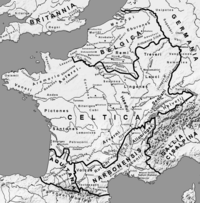History of Marseille
Marseille continued to prosper as a Roman city, becoming an early center of
Marseille lost a significant portion of its population during the Great Plague of Marseille in 1720, but the population recovered by mid century. In 1792 the city became a focal point of the French Revolution and was the birthplace of France's national anthem, La Marseillaise. The Industrial Revolution and establishment of the French Empire during the 19th century allowed for further expansion of the city, although it was captured and heavily damaged by Nazi Germany during World War II. The city has since become a major center for immigrant communities from former French colonies, such as French Algeria.
Prehistory

Humans have inhabited Marseille and its environs for almost 30,000 years: palaeolithic cave paintings in the underwater Cosquer Cave near the calanque of Morgiou date back to between 27,000 and 19,000 BC; and recent excavations near the railway station have unearthed neolithic brick habitations from around 6000 BC.[2][3]
Antiquity

Massalia became one of the major trading ports of the ancient world. At its height, in the 4th century BC, it had a population of about 50,000 inhabitants on about fifty hectares surrounded by a wall. It was governed as an aristocratic republic, with an assembly formed by the 600 wealthiest citizens. It had a large temple of the cult of Apollo of Delphi on a hilltop overlooking the port and a temple of the cult of Artemis of Ephesus at the other end of the city. The drachmas minted in Massalia were found in all parts of Ligurian-Celtic Gaul. Traders from Massalia ventured into France on the rivers Durance and Rhône and established overland trade routes to Switzerland and Burgundy, reaching as far north as the Baltic Sea. They exported their own products: local wine, salted pork and fish, aromatic and medicinal plants, coral, and cork.[11] The most famous citizen of Massalia was the mathematician, astronomer and navigator Pytheas. Pytheas made mathematical instruments, which allowed him to establish almost exactly the latitude of Marseille, and he was the first scientist to observe that the tides were connected with the phases of the moon. Between 330 and 320 BC, he organized an expedition by ship into the Atlantic and as far north as England, and to visit Iceland, Shetland, and Norway, where he was the first scientist to describe drift ice and the midnight sun. Though he hoped to establish a sea trading route for tin from Cornwall, his trip was not a commercial success, and it was not repeated. The Massiliots found it cheaper and simpler to trade with Northern Europe over land routes.[12]

The city thrived by acting as a link between inland
During
It was during this time that
Middle Ages and Renaissance

| History of France |
|---|
 |
| Topics |
| Timeline |
|
|
The city was not affected by
The city regained much of its wealth and trading power in the 10th century under the
The Counts of Provence allowed Marseille, governed by a consul, great autonomy until the rule of
Marseille's population and trading status soon recovered and in 1437, the Count of Provence
Marseille was united with Provence in 1481 and then incorporated into France the following year, but soon acquired a reputation for rebelling against the
18th and 19th centuries


Over the course of the 18th century, the port's defences were improved[29] and Marseille became more important as France's leading military port in the Mediterranean. In 1720, the last Great Plague of Marseille, a form of the Black Death, killed 100,000 people in the city and the surrounding provinces.[30] Jean-Baptiste Grosson, royal notary, wrote from 1770 to 1791 the historical Almanac of Marseille, published as Recueil des antiquités et des monuments marseillais qui peuvent intéresser l'histoire et les arts ("Collection of antiquities and Marseille monuments which can interest history and the arts"), which for a long time was the primary resource on the history of the monuments of the city.
The local population enthusiastically embraced the French Revolution and sent 500 volunteers to Paris in 1792 to defend the revolutionary government; their rallying call to revolution, sung on their march from Marseille to Paris, became known as La Marseillaise, now the national anthem of France. In 1793, the Federalists rise against the Jacobins. The rebellion becomes a monarchist fight against the republic. After the latter's victory, the city is renamed Ville-sans-nom ("Nameless-City") in punishment. In 14 July 1795, La Marseillaise becomes the official anthem and the city recovers its name.[31]
During the 19th century, the city was the site of industrial innovations and growth in manufacturing. The rise of the
Coinciding with, and in support of, the Paris Commune of 1871, the populace established a commune of their own with the aid of local sections of the National Guard. The Commune was quickly suppressed by the army.[33]
1900 up to World War II

During the first half of the 20th century, Marseille celebrated its "port of the empire" status through the colonial exhibitions of 1906 and 1922;
In the interwar period, Marseille was known for its extensive organised crime networks. Simon Kitson has shown how this corruption extended into local administrations like the Police.[35]
During the
Marseille after World War II
After the war, much of the city was rebuilt during the 1950s. The governments of East Germany, West Germany and Italy paid massive reparations, plus compound interest, to compensate civilians killed, injured, left homeless or destitute as a result of the war.
From the 1950s onward, the city served as an entrance port for over a million immigrants to France. In 1962, there was a large influx from the newly independent Algeria, including around 150,000 returned Algerian settlers (pieds-noirs).[37] Many immigrants have stayed and given the city a French-African quarter with a large market.
In December 1994, the
In the 21st century Marseille regularly attracts media attention due to drug trafficking and shootings that take place especially in the north of the city.
See also
References
- ^ Patrick Boucheron, et al., eds. France in the World: A New Global History (2019) pp 30-35.
- ^ J. Buisson-Catil, I. Sénépart, Marseille avant Marseille. La fréquentation préhistorique du site. Archéologia, no. 435, July–August 2006, pages 28–31
- ^ "Marseille before Massalia, the oldest Neolithic unfired brick architecture in France" (Press release). Inrap (Institut national de recherches archéologiques preventives). 15 February 2007. Archived from the original on 24 September 2015. Retrieved 29 May 2017.
- ^ "Online Etymology Dictionary". Etymonline.com. Retrieved 12 March 2013.
- ^ Peregrine, Anthony (14 October 2015). "Marseille city break guide". The Telegraph. Retrieved 9 March 2016.
- ^ Duchêne & Contrucci 1998, p. 42.
- ^ Thucydides, History of the Peloponnesian War 1.13.6
- ^ a b Duboi, Marius; Gaffarel, Paul; Samat, J.-B. (1913). Histoire de Marseille (in French). Marseille: Librairie P. Ruat.
- Guizot, History of France, Vol. I., chap. I., Gaul (Kindle Edition)
- ^ Robb, Graham, The Discovery of Middle Earth, p. 6
- ^ a b Palanque 1990, p. 41.
- ^ Palanque 1990, p. 44.
- ^ Duchêne & Contrucci 1998, pp. 49–54, "Du commerce à l'exploration". Evidence of trade is provided by the circulation of silver drachmas minted in Marseille from 525 BC, as well as exported pottery from 550 BC; wine produced in Marseille was distributed throughout Gaul during this period.
- ISBN 978-0-671-68702-1.
By 500BC Massalia was making its own wine, and its own amphoras to export it.
- ^ Goyau, Pierre-Louis-Théophile-Georges (1913). "Diocese of Marseilles (Massalia)". In Herbermann, Charles (ed.). Catholic Encyclopedia. New York: Robert Appleton Company. The martyrdom of St. Victor took place under the Roman Emperor Maximian.
- ^ Damien Carraz, "Precursors and Imitators of the Military Orders: Religious Societies for Defending the Faith in the Medieval West (11th–13th c.)," Viator 41.2 (2010): 91–111, at 106.
- ^ Damian J. Smith, Crusade, Heresy and Inquisition in the Lands of the Crown of Aragon (c. 1167–1276) (Brill, 2010), pp. 42–47.
- ^ Abulafia 1999, p. 373: "[Some, like] Marseilles, had had their consulates confirmed by the counts and were close to enjoying complete independence. Ramon-Berenguer V set out to reverse this ... Marseille, however, refused ... the Marseillais did recognize Ramon-Berenguer's suzerainty in 1243."
- OCLC 315065012.
- ^ Abulafia 1999, p. 374: "[Marseille] was subdued once and for all in 1263. Probably the major factor in reconciling the Provençal towns to the loss of their independence was their general economic prosperity."
- ^ Duchêne & Contrucci 1998, p. 182.
- ^ Duchêne & Contrucci 1998, pp. 160–161, 174This commandry was a monastery belonging to the military religious order of the crusading Knights Hospitaller. Following Richard the Lionheart's visit in 1190 with the Anglo-Norman fleet during the Third Crusade, Marseille became a regular port of call for crusaders.
- ISBN 2-221-08734-8. (in French)
- ^ Duchêne & Contrucci 1998, page needed B.
- ^ Duchêne & Contrucci 1998Chronology, page 182, and Part III, Chapters 25–36.
- ^ Duchêne & Contrucci 1998, page needed C.
- ^ Leathes, Stanley (1906). Ward, Adolphus William; Prothero, G.W.; Leathes, Stanley (eds.). The Cambridge Modern History. Vol. 10. Cambridge: University Press. p. 72. Retrieved 1 February 2010.
- ^ Duchêne & Contrucci 1998, page needed D.
- ^ 1720 chart of Marseille: a contemporary chart showing the defenses of the port.
- ^ Duchêne & Contrucci 1998, p. 360–378.
- ^ Prin-Derre, Jérémy (2 August 2015). "Marseille, la ville rebelle, devient la Ville-sans-nom". www.laprovence.com (in French). Retrieved 10 November 2023.
- ^ Ghiuzeli, Haim F. "The Jewish Community of Marseilles". The Museum of the Jewish People at Beit Hatfutsot. Retrieved 24 March 2008.
- ^ Milza, Pierre, La Commune, September 10th 2009, pp. 165–170
- ISBN 0-520-22949-5
- ^ Kitson 2014.
- ^ Gilbert, Martin (1986). The Holocaust: The Jewish Tragedy. Collins. pp. 530–531.
- ^ Moore, Damian. "Multicultural Policies and Modes of Citizenship in European Cities: Marseilles" (DOC). UNESCO. Retrieved 5 May 2009.
Works cited
- Abulafia, David, ed. (1999). The New Cambridge Medieval History. Vol. 5. Cambridge University Press. ISBN 0-521-36289-X.
- Duchêne, Roger; Contrucci, Jean (1998). Marseille, 2600 ans d'histoire [Marseille, 2600 Years of History] (in French). Paris: Editions Fayard. ISBN 2-213-60197-6.
- Kitson, Simon (2014). Police and Politics in Marseille, 1936–1945. Amsterdam: Brill. ISBN 978-90-04-24835-9.
- Palanque, J.R. (1990). "Ligures, Celtes et Grecs" [Ligures, Celts and Greeks]. In Baratier, Edouard (ed.). Histoire de la Provence [History of Provence]. Univers de la France (in French). Toulouse: Editions Privat. ISBN 2-7089-1649-1.

